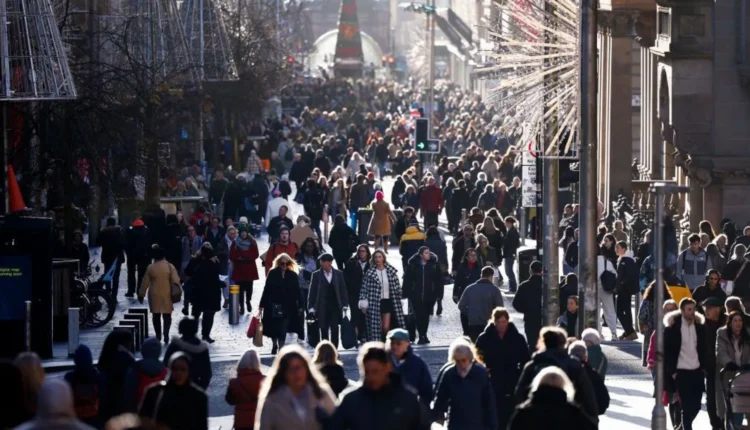Scotland’s deaths outnumber births – so why is the population still rising?
Scotland’s population reached a new high of 5.5 million last year.
However, deaths have outpaced births over the past decade, so why is the population still increasing?
The basic explanation is that more people are relocating to Scotland than are departing, with the majority of new immigrants coming from outside. Scottish ministers claim that positive net migration is critical to the country’s demographic expansion; nevertheless, this assertion is not without criticism.
Backdoor routes to the UK, such as persons entering by tiny boats, continue to make headlines. The majority of Scotland’s recent immigration growth, however, has been driven by front-door options such as foreign student visas.
People moving to start new lives elsewhere was once the primary migration story in Scotland, but that is no longer the case.
Immigration has been increasing the country’s population over the past 24 years. This means that more people move to Scotland each year than leave, with substantial spikes at important occasions like eight Eastern European nations entering the EU in 2004 and Brexit in 2020.
However, the most significant increases have occurred more lately. 68,200 people left Scotland in the year to mid-2024, while 124,600 arrived.
The difference between the two, known as net migration, is 56,400. Three-quarters of the total came from overseas.
According to National Records of Scotland (NRS), international immigration “remains historically high”. Separate snapshot population data reinforces this point.
Scotland’s population increased by 144,400 (2.7%) between the 2011 and 2022 censuses. During this time, the number of Scottish-born residents fell by 90,400. This drop was countered by an increase in those born in the rest of the UK (up 49,200) and abroad (up 185,600). Since 2015, there have been more deaths than births.
The NRS refers to the disparity between the two as “the natural change,” and predicts that it will deepen over the next two decades as individuals have fewer children and the elderly population grows.
According to NRS forecasts, inward migration will continue to cover the natural change gap, and Scotland’s population might reach 5.8 million by 2047. The population of 23 council districts is predicted to increase over the next decade.
However, if current demographic trends, such as dropping birth rates, continue, nine more areas will have declines by mid-2032.
Equalities Minister Kaukab Stewart stated that the data illustrate that Scotland’s population growth is dependent on positive net migration, with migrant workers filling vital skills gaps in areas such as healthcare and agriculture.
What is driving the increase in immigration?
 PA Media
PA MediaOne of the primary drivers of immigration to Scotland in recent years has been the entry of more overseas students and their dependents. In 2022/23, an all-time high of 83,975 students from outside the UK were studying in the country.
However, the number of EU students in Scotland has dropped by half, down to just 10,430, since Brexit. Foreign students have increased from one in every twenty in the 1990s to more than one in every four today.
This followed Boris Johnson’s post-Brexit revisions, which made it simpler for non-EU nationals and their families to obtain visas. China remains the biggest supplier of international students to Scotland with 17,565 enrolments last year, up from 14,275 in 2019/20.
It is a significant money maker for colleges since international students pay greater fees. Universities Scotland estimates that international students have contributed between £4 and 6 billion to Scotland’s economy since 2019.
However, the number of international students at Scottish universities fell by more than 10,000 last year, causing major financial challenges for some schools, including Dundee University.
People arrive in Scotland on pre-arranged work visas, which can range from international footballers to agricultural and care home staff.
It is unclear how many people and their dependents arrive in Scotland each year on skilled worker visas.
However, in recent years, the number of health and care-related visas issued in the UK has tripled to fill staffing needs, prior to a tightening of the regulations.
What is not represented in any of the data is the amount of unauthorised migrants living in the country, such as those who overstay their holiday visas or who are denied asylum but do not leave.
More than 20 years have passed since the UK government attempted to estimate this figure.
But what about refugees and asylum seekers?
People seeking refugee or asylum status in the UK also travel to Scotland, however the number is modest, accounting for only 0.67% of the overall population.
According to Home Office figures up to June, 28,934 Ukrainians have migrated to the UK under a resettlement scheme since Russia’s invasion of Ukraine.
In addition, 1,875 Afghans are residing in Scotland as part of the Afghan resettlement scheme. However, the number of asylum seekers residing in the country has received the greatest attention in recent months.
 PA Media
PA MediaWhich parts of Scotland have the most migrants?
Last year, more individuals moved in than out of every Scottish council area, according to NRS data.
The largest increase in net migration was in Glasgow, which increased by 1.8% (11,540 people) from mid-2023, followed by Midlothian at 1.5% (1,510 people) and Edinburgh at 1.2% (6,540).
According to NRS study, 23 of Scotland’s 32 local areas would see population growth by mid-2032, with Edinburgh anticipated to grow by about 10% and Midlothian by 14.7%.The remaining areas, such as West Dunbartonshire and Inverclyde, are anticipated to witness population declines.
Ross Bond, a senior lecturer in sociology at the University of Edinburgh, conducted an analysis of the 2022 Census, which revealed that one in every 10 respondents was born outside of the UK, up from 3.8% in the 2001 census.
According to his research, the bulk of persons arriving from overseas are under the age of 25, and many of them live in cities.
Read more on Straightwinfortoday.com


Comments are closed, but trackbacks and pingbacks are open.